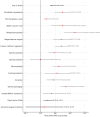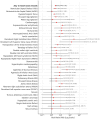Ultrasonographic findings in mid-trimester adolescent pregnancy: prevalence and risk of abnormalities
- PMID: 40370745
- PMCID: PMC12074930
- DOI: 10.3389/fmed.2025.1525149
Ultrasonographic findings in mid-trimester adolescent pregnancy: prevalence and risk of abnormalities
Abstract
Background: Adolescent pregnancy, defined as pregnancy in females aged 19 or younger, is associated with higher risks for adverse outcomes compared to older women. Ultrasound imaging during the mid-trimester is crucial for prenatal care, providing insights into fetal development and maternal health.
Objective: The primary aim of this study is to evaluate and compare mid-trimester ultrasound findings between adolescent and older pregnant women and to assess the prevalence and risk of any abnormalities detected during ultrasound examinations.
Methods: This retrospective study was conducted in the Silesian Voivodeship, Poland, from January 1, 2004, to February 29, 2024. Data were collected from reference prenatal centers. The study included 37,366 individuals, of which 1,152 were adolescents. Participants underwent second-trimester prenatal screening, and ultrasound findings were categorized into fetal abnormalities and maternal factors.
Results: The study found significant differences in ultrasonographic findings across different age groups. Adolescent pregnancies showed a higher prevalence of fetal abnormalities, 437.075 per 1,000 pregnancies (95% CI: 409-465). Brain, spine, facial, heart, and urinary tract abnormalities were notably higher in group adolescents.
Conclusion: Adolescent pregnancies are associated with increased detection of various fetal abnormalities during mid-trimester ultrasound scans. Contrary to common belief, the young age of adolescent pregnant individuals does not protect against fetal abnormalities. These findings underscore the necessity for comprehensive, population-based ultrasound screening for pregnant adolescents and the classification and management of adolescent pregnancies as high-risk.
Keywords: adolescent pregnancy; fetal abnormalities; maternal-fetal medicine; teenage pregnancy; ultrasonography.
Copyright © 2025 Staniczek, Manasar-Dyrbuś, Stojko, Sodowska, Rybak-Krzyszkowska, Kondracka, Sadłocha, Sodowski, Włoch, Czuba, Cnota, Illa and Drosdzol-Cop.
Conflict of interest statement
The authors declare that the research was conducted in the absence of any commercial or financial relationships that could be construed as a potential conflict of interest.
Figures







References
LinkOut - more resources
Full Text Sources

